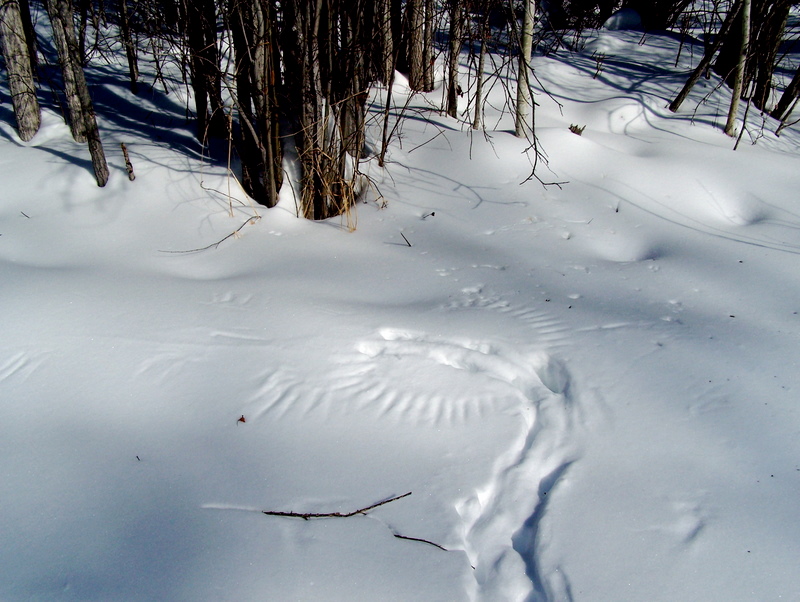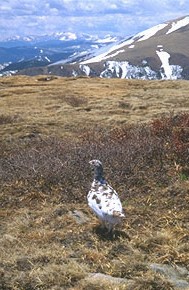| Readings |
- LC
Chapter 4: p90-120 (3rd ed: p93-125)
(=sections for mammals & birds; also
assigned for Winter Mammalogy)
- LC Chapter
7: p215-222 (3rd ed:
p231-238) (=section on Gallinaceous Birds,
e.g. White-tailed Ptarmigan)
|
|
| Lesson
points (with
parallels to those for mammals) |
- What are the major
survival issues for birds in winter?
- What are Physiological,
Morphological, and Behavior adaptations
for coping with these issues?
- many, many ... so
organize these in terms of (e.g., give
examples of) the next 2 '●'
questions –
- How are these integrated
together to give bird solutions to
winter conditions?
- What is the
relationship between bird migratory
behavior and food preferences
(expressed morphologically and
physiologically)?
- What are some
adaptations in birds that involve
strongly linked physiology and
morphology? How does this
integration work? -
- That is,
for a given linked adaptation - what
are the physiological mechanisms and
how do they depend on the
morphology?
- What is the equation for
thermal flux? How do
winter-resident birds 'manipulate' each
term to reduce heat loss?
- Generally, to what
taxonomic families do winter-resident
birds belong?
- What winter
adaptations typify each of these
groups?
- What defines a
"keystone" species?
- What is an example of
a keystone species whose impact is
expressed in the winter survival of
other bird species?
- Continued under Field
Lesson Points (below)
|

Woodpecker
(photo
©Gerry Buckel,
used
withpermission
http://www.flickr.com/photos/91515698@N00/3106601571/) |
| Other Resources |
- No
Room at the Top, by Paul Tolmé. National
Wildlife, 44(1): 22-30 (Dec-Jan 2006)
– High mountain species and
global warming. Also listed for
Winter Mammal Ecology (Week IV)
- Song
of the Alpine: The Rocky Mountain
Tundra Through the Seasons, by Joyce
Gellhorn (2002, Johnson Books,
Boulder). Chapters 7, 10, 12 provide
an description of animal responses to
winter. - also listed for Winter Mammal
Ecology (Week IV)
- Made
for Each Other. A Symbiosis of Birds and
Pines, by R.M. Lanner (1996, Oxford
Univ Press). This book nicely lays out
the details of the coevolved interaction
between Clark's Nutcracker (and related
Corvids) and the 'Soft pines' (Limber Pine,
Pinyon, and related spp.). Chapter 6
discusses their ability to find pinenut
caches in winter. (Selected
figures handout)
|
|
7.20a – Weather Briefing -
Current
Weather & Forecasts: (MRS)
and Allenspark/Wild
Basin forecast
- Daily Weather
Discussion handouts: Archive
7.25a – Leave for Allenspark and
Wild Basin (RMNP)
Special Note re
Arriving at the Fawn Brook Inn:
-
When you pull up, it's best to not pull up
right under/near the feeders: so as not
to disturb birds around the feeders (and
people watching them).
-
Probably best to either park on the other side
of the street, or in the lot but as far away
from the feeders/house as one can get.
This way, perhaps we'll get lucky and have a
big flock of rosy-finches there when we
arrive.
|
8:00a-12:30p – Field:
Birds of the Front Range montane forest and their
winter ecology – Guest field instructor: Arvind Panjabi,
Director, International Programs, Bird
Conservancy of the Rockies
Possible
stop at the Meadow Mountain Cafe, Allenspark (303
747-2541)
FIELD -
| Bring |
- Extra layers of clothing
for standing in the cold
- Flotation
gear not needed, just good warm boots
- if you have: "Yak Trax"
(for boots' grip on ice, depending on road
conditions at both sites, esp. Wild Basin)
- Field
Journal
- Food,
snacks (we'll be back at the Lodge for
late lunch)
- Cash
for coffee/tea/2nd breakfast - They do
accept credit cards ($20 minimum
order)
- If
you have:
- Binoculars
- Field guide to birds
- Books or App's:
- Fieldguide
app's - including:
- Birdwatcher's
apps -
- BirdLog
(iOS and Android)
- Birdwatcher's
Diary (iOS)
- Audubon
Ultimate Nature (iOS)
- Count
Circle (iOS)
- BirdTunes
(iOS)
- hand/feet
warmer
packs
|
Handouts / Other
|
Other
resources:
|
Lesson
points
|
- Review Lesson points
above
From your observations --
- What was the difference
in species richness and "natural"
densities of birds you observed in Wild
Basin vs. those at Allenspark?
- To what taxonomic
families did the winter-resident birds
you observed belong?
- What winter adaptations
typify each of these groups?
|
| Resources |
- The
Birder's Handbook, by Paul Ehrlich,
David Dodson, & Darryl Wheye (1988,
Simon & Schuster, NY).
- See
essays on:
- Temperature
regulation and behavior, p 149ff.
- Metabolism,
p 325ff.
- Irruptions,
p 639
- Winter
feeding by redpolls and crossbills, p
641ff.
- Mammal
and bird species lists for Niwot Ridge
(alpine areas):
|
| More re birds |
|
| More re RMNP |
|
1:00p – return
to MRS, lunch
2:00-5:00p – LAB:
Overwintering birds of Front Range montane forest
and alpine tundra: Winter adaptations
| Handouts |
|
| Lesson
points |
See Bird Winter Ecology Lesson points above |
| Resources |
- Colorado
Birds.
A
Reference to Their Distribution and
Habitat, by R. Andrews & R.
Righter (1992, Denver Museum of Natural
History. ISBN 0-916278-68-9, $25).
- Atlas
of Wintering North American Birds.
An Analysis of Christmas Bird Count Data,
by Terry Root (1988, Univ of Chicago
Press. ISBN 0-226-72540-5)
- The
Birder's Handbook, by Paul Ehrlich,
David Dodson, & Darryl Wheye (1988,
Simon & Schuster, NY).
- The
Sibley Field Guide to Birds of Western
North America, by D.A. Sibley (2003,
Knopf)
- B.
Heinrich and R. Bell. 1995.
Winter Food of a Small Insectivorous Bird,
the Golden-Crowned Kinglet. The Wilson
Bulletin 107: 558-561 (pdf,
250k)
|
| More |
- Snow
prints of an owl having caught a rabbit

|
click
on image to enlarge

photo
|
|
|

 Winter Ecology
Schedules and Readings
Winter Ecology
Schedules and Readings 
